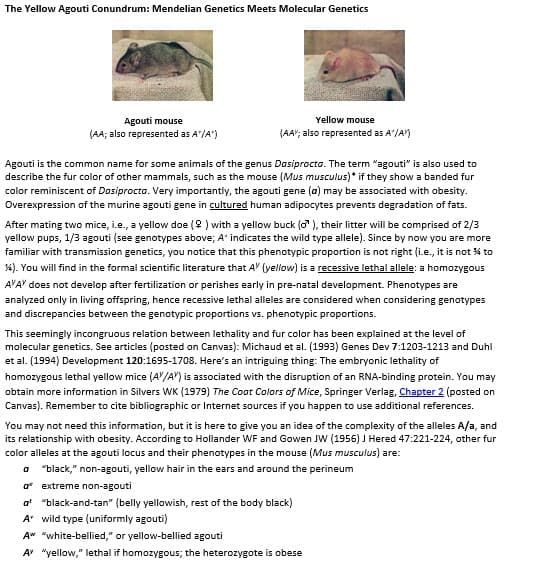1. A heterozygous mouse AAy does not produce enough pigment and it is yellow. Homozygous individuals die during development, but AAy heterozygous do not. Why? You may use any graphic aid to explain this, if necessary. This means that you may use a Punnett square or a forking segregation diagram, or computations with fractions. 2. Explain why there is a non-Mendelian 2:1 yellow/agouti phenotypic ratio in this cross. 3. What is the Raly gene? What does it encode? How does it relate to the lethality of Ay?
1. A heterozygous mouse AAy does not produce enough pigment and it is yellow. Homozygous individuals die during development, but AAy heterozygous do not. Why? You may use any graphic aid to explain this, if necessary. This means that you may use a Punnett square or a forking segregation diagram, or computations with fractions. 2. Explain why there is a non-Mendelian 2:1 yellow/agouti phenotypic ratio in this cross. 3. What is the Raly gene? What does it encode? How does it relate to the lethality of Ay?
Human Heredity: Principles and Issues (MindTap Course List)
11th Edition
ISBN:9781305251052
Author:Michael Cummings
Publisher:Michael Cummings
Chapter6: Cytogenetics: Karyotypes And Chromosome Aberrations
Section: Chapter Questions
Problem 1CS: Genetics in Practice case studies are critical-thinking exercises that allow you to apply your new...
Related questions
Question
1. A heterozygous mouse AAy does not produce enough pigment and it is yellow. Homozygous individuals die during development, but AAy heterozygous do not. Why? You may use any graphic aid to explain this, if necessary. This means that you may use a Punnett square or a forking segregation diagram, or computations with fractions.
2. Explain why there is a non-Mendelian 2:1 yellow/agouti
3. What is the Raly gene? What does it encode? How does it relate to the lethality of Ay?

Transcribed Image Text:The Yellow Agouti Conundrum: Mendelian Genetics Meets Molecular Genetics
Yellow mouse
Agouti mouse
(AA; also represented as A'/A")
(AA"; also represented as A/A)
Agouti is the common name for some animals of the genus Dasiprocta. The term "agouti" is also used to
describe the fur color of other mammals, such as the mouse (Mus musculus)* if they show a banded fur
color reminiscent of Dosiprocta. Very importantly, the agouti gene (a) may be associated with obesity.
Overexpression of the murine agouti gene in cultured human adipocytes prevents degradation of fats.
After mating two mice, i.e., a yellow doe (9 ) with a yellow buck ( ), their litter will be comprised of 2/3
yellow pups, 1/3 agouti (see genotypes above; A' indicates the wild type allele). Since by now you are more
familiar with transmission genetics, you notice that this phenotypic proportion is not right (i.e., it is not % to
%). You will find in the formal scientific literature that A' (yellow) is a recessive lethal allele: a homozygous
A'A" does not develop after fertilization or perishes early in pre-natal development. Phenotypes are
analyzed only in living offspring, hence recessive lethal alleles are considered when considering genotypes
and discrepancies between the genotypic proportions vs. phenotypic proportions.
This seemingly incongruous relation between lethality and fur color has been explained at the level of
molecular genetics. See articles (posted on Canvas): Michaud et al. (1993) Genes Dev 7:1203-1213 and Duhl
et al. (1994) Development 120:1695-1708. Here's an intriguing thing: The embryonic lethality of
homozygous lethal yellow mice (A'/A") is associated with the disruption of an RNA-binding protein. You may
obtain more information in Silvers WK (1979) The Coat Colors of Mice, Springer Verlag, Chapter 2 (posted on
Canvas). Remember to cite bibliographic or Internet sources if you happen to use additional references.
You may not need this information, but it is here to give you an idea of the complexity of the alleles A/a, and
its relationship with obesity. According to Hollander WF and Gowen JW (1956) J Hered 47:221-224, other fur
color alleles at the agouti locus and their phenotypes in the mouse (Mus musculus) are:
a "black," non-agouti, yellow hair in the ears and around the perineum
a* extreme non-agouti
a' "black-and-tan" (belly yellowish, rest of the body black)
A wild type (uniformly agouti)
A" "white-bellied," or yellow-bellied agouti
A "yellow," lethal if homozygous; the heterozygote is obese
Expert Solution
This question has been solved!
Explore an expertly crafted, step-by-step solution for a thorough understanding of key concepts.
This is a popular solution!
Trending now
This is a popular solution!
Step by step
Solved in 2 steps

Recommended textbooks for you

Human Heredity: Principles and Issues (MindTap Co…
Biology
ISBN:
9781305251052
Author:
Michael Cummings
Publisher:
Cengage Learning

Biology: The Unity and Diversity of Life (MindTap…
Biology
ISBN:
9781305073951
Author:
Cecie Starr, Ralph Taggart, Christine Evers, Lisa Starr
Publisher:
Cengage Learning

Biology 2e
Biology
ISBN:
9781947172517
Author:
Matthew Douglas, Jung Choi, Mary Ann Clark
Publisher:
OpenStax

Human Heredity: Principles and Issues (MindTap Co…
Biology
ISBN:
9781305251052
Author:
Michael Cummings
Publisher:
Cengage Learning

Biology: The Unity and Diversity of Life (MindTap…
Biology
ISBN:
9781305073951
Author:
Cecie Starr, Ralph Taggart, Christine Evers, Lisa Starr
Publisher:
Cengage Learning

Biology 2e
Biology
ISBN:
9781947172517
Author:
Matthew Douglas, Jung Choi, Mary Ann Clark
Publisher:
OpenStax